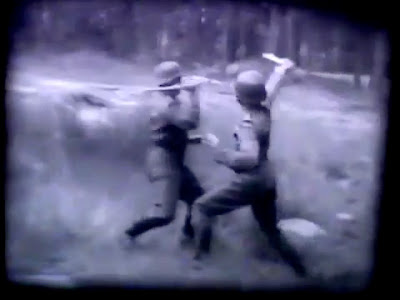Lähitaistelu (Close Combat) Part 1 - Introduction - A Detailed Look at the 1950's Finnish Combatives Film
The Finnish Military film 'Lähitaistelu', literally 'close combat' or 'melee combat' is said to date from 1957 and provides an interesting look at what I like to call the re-engineering of Jujutsu (1). In some ways, the system is extremely sophisticated, with a high degree of systematisation and some complex training exercises.
For the most part, I don't want to add detailed commentary as what appears in the film is self-explanatory and I am unable to understand the Finnish soundtrack - for all I know it may show something and be saying "never do this".
The first part of the film is somewhat of an introduction, but I have included it as it shows physical training (reminiscent of the old Camp X footage) and some shooting. The film is broken up into sections, and I will, therefore, make one post per section in the manner of the film.
Lähitaistelu (close combat)
Highlights from coming sections:
Sub-machine gun training with moving and pop-up targets:
Physical training:
(1)What I mean when I call Combatives the re-engineering of Jujutsu is this:
The fathers of 'Modern Combatives', really being Fairbairn and Sykes, took a comprehensive system developed for policing from various martial arts as a toolbox, and they pulled from this toolbox a subsystem for use by insurgents, agents and special forces soldiers. This system was bare bones but brutally effective.
As time went on this system became quite commonplace, however, it was developed to be taught to people who would be deployed soon and have to use it. At the end of WW2 things went back to normal in many parts of the world in terms of deployment (if not politics), so training time extended and the focus broadened.
At this stage, we see what are essentially expanded versions of the WW2 system. People began to try and re-engineer more complete systems from the subsystem - be they for military, civilian or police use. A lot of the time the incubation pool for these additions was not hardcore policing or combat, rather it was modern Budo, such as Judo and even Aikido and Karate, or sports such as boxing and wrestling (or again, Judo).
The success of these attempts varies - however they are typically more effective than modern Jujutsu systems that do not take WW2 Combatives as part of their DNA and instead are put together only from modern Budo and sports.
The original film is here:





























